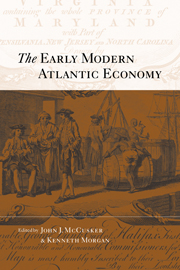Book contents
- Frontmatter
- Contents
- List of figures
- List of tables
- List of abbreviations
- List of contributors
- Dedication
- Introduction
- Part I The role of merchants and their connections
- 1 Risk, credit and kinship in early modern enterprise
- 2 Business networks in the British export trade to North America, 1750–1800
- Part II The development of trades
- Part III Imperial economies
- Part IV Colonial working societies
- Index
2 - Business networks in the British export trade to North America, 1750–1800
from Part I - The role of merchants and their connections
Published online by Cambridge University Press: 16 October 2009
- Frontmatter
- Contents
- List of figures
- List of tables
- List of abbreviations
- List of contributors
- Dedication
- Introduction
- Part I The role of merchants and their connections
- 1 Risk, credit and kinship in early modern enterprise
- 2 Business networks in the British export trade to North America, 1750–1800
- Part II The development of trades
- Part III Imperial economies
- Part IV Colonial working societies
- Index
Summary
This chapter offers an analysis of business networks in the British export trade to North America in the second half of the eighteenth century, a significant yet relatively understudied topic in transatlantic commercial enterprise. A framework for the discussion is provided by selected aggregate data plus some comments on the changing role of British exports between 1750 and 1800. Valuations based on ‘official’ prices in customs ledgers provide a good index of trade volume. These show that English exports to North America more than trebled in value from £256,000 in 1700–1 to £971,000 in 1750–1, when they accounted for 10.6 per cent of total exports. British exports to North America more than doubled in value from £2,649,000 in 1772–3 to £5,700,000 in 1797–8, when they comprised 31.2 per cent of exports. The lure of markets in North America was particularly important for British textile industries. By the 1790s anything between a third and a half of the exports in Britain's fastest growing industry cotton – were dispatched to the United States of America. By the turn of the nineteenth century, 40 per cent of British wool textile exports were similarly sent to North American markets.
This growth of exports to North America reflected the ‘empire of goods’ that bound together Britain and its American colonies before the War of Independence, and the continuing commercial links between Britain and the United States after 1783.
- Type
- Chapter
- Information
- The Early Modern Atlantic Economy , pp. 36 - 62Publisher: Cambridge University PressPrint publication year: 2001
- 4
- Cited by

